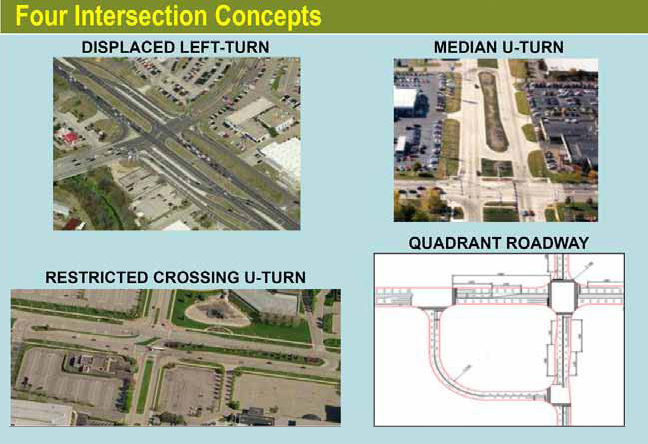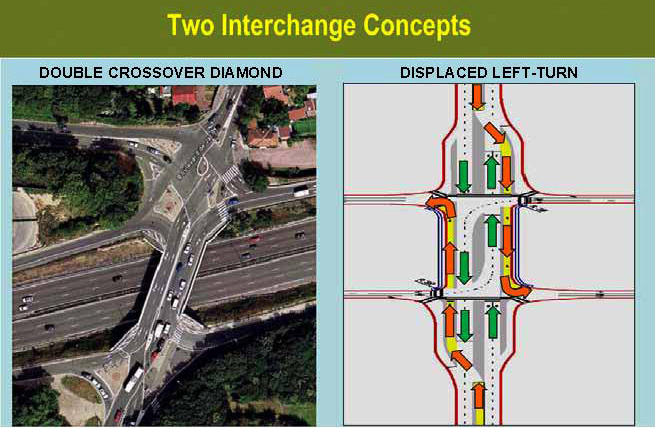Cmf of Continuous Flow Intersections Definition
Publication Number: FHWA-HRT-09-060
Date: April 2010
Alternative Intersections/Interchanges: Informational Report (AIIR)
CHAPTER 1. INTRODUCTION
Today's transportation professionals are challenged to meet the mobility needs of an increasing population with limited resources. At many highway junctions, congestion continues to worsen. Drivers, pedestrians, and bicyclists experience longer delays and greater exposure to risk. Today's traffic and safety problems are more complex and complicated than ever, and conventional intersection designs are sometimes found to be insufficient to mitigate transportation problems. Consequently, many engineers are investigating and implementing innovative treatments in an attempt to improve mobility for roadway users.
This report describes alternative intersection and interchange designs that may offer additional benefits compared to conventional at-grade intersections and grade-separated diamond interchanges. The objective of this report is to present information on selected alternative designs. This report is not a guidebook, and it does not constitute a standard, specification, or required practice. It is an attempt at disseminating information about selected treatments that may not be generally considered for implementation during the alternatives analysis phase. The intended audience of this report is the group of transportation professionals engaged in the planning, design, and operation of interchanges and intersections.
The six alternative treatments presented in this report are identified in table 1. In addition, the general locations where these treatments have been or will be implemented are also presented in table 1. Figure 1 shows illustrations of the four alternative intersection configurations.
Table 1. Installations of selected alternative intersection and interchange treatments in the United States and other countries.
| Alternative Intersection/Interchange Treatment | Installations |
|---|---|
| Displaced left-turn (DLT) intersection | Maryland, New York, Louisiana, Utah, Mexico, and United Kingdom. |
| Median U-turn (MUT) intersection | Michigan, Florida, and Louisiana. |
| Restricted crossing U-turn (RCUT) intersection | Maryland and North Carolina. |
| Quadrant roadway (QR) intersection | No known U.S. implementations yet although variants exist. |
| Double crossover diamond (DCD) interchange | Three locations in France and an implementation by the Missouri Department of Transportation. |
| DLT interchange | No known U.S. implementations yet. |

Figure 1. Photo. Four alternative intersection configurations.
While the four alternative at-grade intersection designs are noticeably different from each other, there is common aspect among them. These alternative designs all attempt to remove one or more of the conventional left-turn movements from the major intersection. By removing one or more of the critical conflicting traffic maneuvers from the major intersection, fewer signal phases are required for signal operation. This can result in shorter signal cycle lengths, shorter delays, and higher capacities compared to conventional intersections.
DLT intersections are also referred to as continuous flow intersections (CFI) and crossover displaced left-turn intersections (XDL). At conventional intersections, left-turn movements are frequently made from separate left-turn lanes directly onto the crossroad. Drivers turning left must cross the path of the oncoming through traffic from the opposite direction. At a displaced left-turn (DLT) intersection, left-turn traffic is laterally displaced. In other words, left-turning traffic crosses over the opposing through movement at a location that is several hundred feet upstream of the major intersection. This upstream crossover location is typically signal controlled. The left-turning traffic then travels on a separated roadbed, which is on the outside of the opposing through lanes, as those vehicles proceed toward the major intersection. When these left-turning motorists reach the major intersection, they can proceed without conflict concurrently with the opposing through traffic.
The median U-turn (MUT) intersection, which is also referred to as Michigan lefts, has been used extensively in Michigan. At an MUT intersection, left turns are not allowed at the major intersection. Rather, drivers turning left from the major approach must first proceed through the intersection. At a location that is several hundred feet downstream of the major intersection, these drivers can make a U-turn, travel back toward the intersection, and then subsequently execute a right turn onto the crossroad. This type of treatment is most effective on boulevard-type streets with wide medians. The MUT intersection can be classified as either a partial MUT intersection or a full MUT intersection. At a partial MUT intersection, the side road approaches operate in a manner similar to the side road approaches at conventional intersections. Specifically, left-turn movements can be made directly from left-turn lanes on the side road approaches. For partial MUT intersections, left turns from the major road at the intersection with the crossing side road are prohibited. At a full MUT intersection, no left turns are permitted from either the major road or the intersecting side road.
The restricted crossing U-turn (RCUT) intersection, also known as a super street intersection, is similar to the MUT intersection treatment in that left-turning traffic from the minor-road approach must first turn right and then execute a U-turn maneuver downstream. The distinguishing characteristic is that the through and left-turn maneuvers are not allowed from the side road. Rather, all traffic approaching the major road on the side road must first turn right onto the major road, travel a short distance downstream on the major road, and then make a U-turn on the major road. Drivers on the side street who want to go through on the side road can then make a right turn from the major roadway onto the side road. While conventional intersections can be converted to RCUT intersections at individual spot locations, the RCUT intersection treatment is more applicable as a treatment applied to arterial segments. Another form of the RCUT intersection is the J-turn intersection, named by the Maryland State Highway Administration (MDSHA). At a J-turn intersection, traffic signal control is not installed, but all traffic from the side road must turn right onto the arterial. Left turns from the major arterial are still permitted at the crossroad similar to a conventional intersection. This treatment is typically implemented where left-turn volumes and side road volumes are relatively low. The benefit of the J-turn intersection is that it allows the major arterial through traffic to proceed without stopping for traffic signal control.
The quadrant roadway (QR) intersection is a design at which the mainline left-turn movements are relocated to a connector roadway that is located in one of the quadrants. The connector roadway provides a separate connection between the major road and the crossroad. Drivers who want to turn left from the major road at a conventional intersection turn left onto this connector roadway at a location upstream from the major intersection. They then turn left again from the connector roadway to the cross street. At the time of this report, there are no known QR intersections in the United States if held to the strict definition that no left turns are allowed at the primary intersection. However, there are many locations where one or more left-turn movements have been prohibited at the primary intersection and directed via existing streets in the local roadway network. The removal of even one left-turn movement from a heavily congested intersection can reduce delays and improve flow through the intersection. Therefore, the QR intersection, in its purest form, removes all left turns from the primary intersection in an attempt to maximize throughput on both the major and minor intersecting roadways.

Figure 2. Photo. Two alternative interchange configurations.
The two alternative interchange treatments examined in detail in this report are alternatives for a conventional diamond interchange, which are shown in figure 2. The double crossover diamond (DCD) interchange, also referred to as diverging diamond interchange (DDI), features a reversal of the directional traffic movements on the crossing arterial roadway through the interchange area. At a conventional diamond interchange, left turns are executed across the path of opposing through traffic. By flipping the traffic streams within the interchange area, the conflict between the left turn from the major road and the opposing through movement can be removed. Left-turning traffic from the major road onto an on-ramp to the freeway can be made without conflict from the opposing traffic. This resulting movement is analogous to a right turn from the major road to a ramp at a conventional diamond interchange.
The other alternative interchange treatment documented in this report is the DLT interchange. Operationally, it is analogous to a DLT intersection and can be thought of as a DLT intersection implemented at a diamond interchange. The treatment removes the conflict between the left turn onto the on-ramp and the opposing through movement. By displacing the left turn, opposing through movements can move concurrently during the same signal phase when traffic is turning left to the ramp. However, as opposed to the DCD interchange, the DLT interchange does not require the reversal of the directional through movements.
Among the intersections in this report, DLT intersections have been implemented at five locations in the United States, with several implementations in Mexico and some in the United Kingdom. The MUT intersections are the most common form within the United States, with many existing implementations in Michigan and some in Florida and Louisiana. The RCUT intersection has been implemented in both the signalized and unsignalized forms in North Carolina. In Maryland, they are in the unsignalized form and are referred to as J-turns. Although several variations of QR intersections exist in the United States, there are no known pure forms of this intersection.
Regarding the two interchange forms detailed in this report, the DCD interchange exists at a known location in Versailles, France, and two other locations near Paris, France. The designs for two DCD interchanges have been prepared and are expected to be constructed in Kansas City, MO, and Springfield, MO.
This report discusses the following main topics:
- Alternative intersection treatments (chapters 2 through 6).
- Alternative interchange treatments (chapters 7 through 9).
- Processes to assist transportation professionals in selecting alternative intersection/ interchange treatments (chapter 10).
Chapters 2 through 6 discuss the alternative at-grade intersections and provide knowledge of each intersection treatment including its salient geometric design features, operational and safety issues, access management issues, costs, construction sequencing, and applicability. Additional alternative intersections not discussed in detail in this report are briefly described at the end of chapter 6.
Chapters 7 through 9 discuss the two alternative grade-separated interchanges and provide knowledge of each interchange treatment including its salient geometric design features, operational and safety issues, access management issues, costs, construction sequencing, and applicability. Chapter 9 provides descriptions of two grade-separated interchanges that are popular among designers, namely, the compressed or tight urban diamond interchange (TUDI) and the single point urban interchange (SPUI). Additional innovative interchanges not discussed in detail in this report are described briefly in chapter 9.
Chapter 10 presents a process that transportation professionals could use to identify and assess alternative at-grade intersection designs. The process was devised so that potentially feasible alternative intersection designs that are often not considered would be included at a sketch planning level during an alternative analysis stage. The assessment procedure uses a set of criteria that cover operational, safety, right-of-way, and pedestrian issues. The criteria presented in chapter 10 could encourage the advancement of a broader range of alternative intersection designs to subsequent phases in project planning and preliminary design processes.
Source: https://www.fhwa.dot.gov/publications/research/safety/09060/001.cfm
0 Response to "Cmf of Continuous Flow Intersections Definition"
Post a Comment